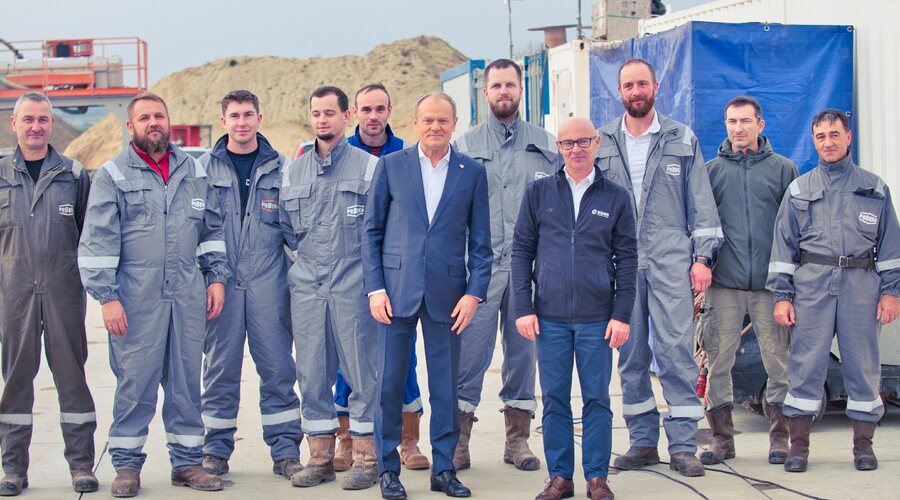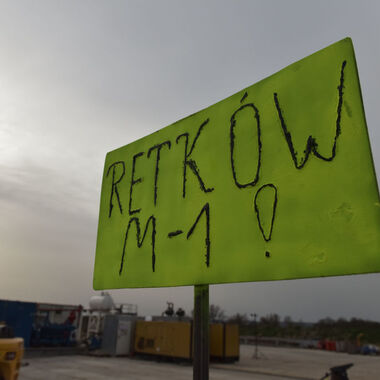KGHM: construction of the deepest mining shaft in Poland has begun. Key investments for the Company and the region are gaining momentum
Geological and hydrogeological drilling for the Retków project is the first stage in the construction of the deepest mine shaft in Poland. Its planned depth is approximately 1360 m. The site visit was attended by Prime Minister of the Republic of Poland Donald Tusk, Minister of State Assets Wojciech Balczun and Secretary of State at the Ministry of State Assets Eliza Zeidler. The meeting focused on the development of copper mining in Poland, the importance of new investments for the region and the leading role of Polish companies in implementing KGHM's new projects.
During the visit, Prime Minister Donald Tusk referred to the development of KGHM and the importance of copper for the modern Polish economy. ‘It gives me great satisfaction to be in a place which gives hope for a very serious undertaking and very serious future profits, not only counted in money from the sale of the product which KGHM offers in Europe and around the world. Copper, like other metals, is also taking on geopolitical significance. It is both our economic security and the security of KGHM and the region’.
As Donald Tusk pointed out: ‘Copper is an absolutely strategic raw material in such important industries as the energy sector in particular. Just one wind tower needs nearly 5 tonnes of copper, a combustion engine car needs 30 kg and an electric car more than 80 kg of copper. This shows how important copper is not only to us, but how important an asset it is, even politically’.
‘I am very thankful that in thinking about this project, KGHM is adhering to the idea of re-Polonisation and the principle of local content, where Polish companies will be practically entirely responsible for this project. This will provide jobs for several thousand people for years to come’, the Prime Minister added.
‘KGHM must grow. And that is why we have already decided that the copper tax should be less of a burden for KGHM, and in time, as the work progresses, this tax context will be more and more favourable. This is not only in the interest of the company, but in the interest of us all’, concluded the head of the Polish government.
Minister of State Assets Wojciech Balczun noted: ‘The commencement of the investment in the new shafts by KGHM is an important investment project for the entire Polish economy and not only in the perspective of the next few years. Copper is an essential raw material for achieving the energy transition and building a modern economy. But this endeavour is also important because local companies are involved - a practical dimension to the implementation of our priority of increasing the participation of Polish medium-sized and smaller companies in large, important investments by companies co-owned by the State Treasury. Projects carried out in this way benefit the Polish economy and Polish citizens.
‘The planned reduction of the copper tax from 2026 supports the unprecedented investments that are now being made after years of neglect and lack of important investments in the company. They open up operational opportunities for many decades and will provide employment for thousands of people. Such tax changes show that we can take care of the Polish economy and that our priority is its growth. I congratulate the management and employees of KGHM and believe that the company's performance and value will continue to grow’, the Minister added.
President of the Management Board of KGHM Polska Miedź S.A. Andrzej Szydło thanked the Prime Minister and government representatives for the dialogue on changes to the tax on the mining of some minerals and emphasised the importance of the started investment projects for KGHM, the Copper Belt and the country’s economy:
‘KGHM is one of the few companies that not only talks about the raw material independence of Poland and Europe, but also takes real action to achieve it. Our priority is to invest in Poland, in the Main Process Line. In the medium to long term, we will allocate tens of billions of zlotys to this purpose. This will also be possible thanks to the changes to the so-called copper tax adopted by the government and currently being debated in the parliament. Optimising its formula does not necessarily mean a reduction in budget revenue. The development of domestic copper mining production is a mutual benefit for both KGHM and the owner of the deposit. At the KGHM Group, we employ tens of thousands of people in Poland, we are among the largest CIT taxpayers, and we plan and implement many investment projects, cooperating primarily with Polish companies. KGHM and the Copper Belt are an example of the benefits that can be achieved through the practical implementation of local content principles’, said Andrzej Szydło, President of the Management Board of KGHM Polska Miedź S.A. ‘The market for so-called foreign inputs and copper scrap is becoming increasingly difficult due to demand outstripping supply. It is becoming critical to optimise and develop domestic mining operations. In each time horizon, we see the greatest added value precisely in the production of mined copper from domestic deposits. Unfortunately, investment in mining has not been a priority for KGHM in recent years and we now have a lot of catching up to do. We do, however, have competences in mining and metallurgy that is unique in the world. They may also be attractive to other European countries. Without copper, silver and also rare earth elements, we will not be able to speak of true raw material independence for our continent. The development of the European mining industry, including KGHM, is also a benefit to the world, as the carbon footprint of our main products is lower than the average of global indices thanks to the application of ESG best practices’, added President Szydło.
The person supervising the construction of the new shafts, Zbigniew Bryja, Vice President of the Management Board of KGHM Polska Miedź S.A., stated:
‘The new investments are a landmark moment for KGHM's long-term development and the future of our deposit development plan. By taking care of domestic copper mining, smelting and refining capacities, we not only strengthen our raw material security, but also significantly support the development of the Polish economy. The contractors for our investment projects are Polish companies, employing workers from the Copper Belt. We mainly use domestic machinery and Polish materials. The performance of KGHM's investment projects has been supported for decades by specialist entities in our Group, and PeBeKa S.A. and Cuprum sp. z o.o. Research and Development Centre are responsible for the current stage of work on the three new shafts’,
said Zbigniew Bryja, Vice President of the Management Board of KGHM Polska Miedź S.A. ‘The construction of three mine shafts at the same time is a huge operational challenge, requiring detailed planning and the experience of the teams and companies involved. Construction of the first surface facilities for the Retków shaft will begin in the first half of 2027, and for another shaft in 2028 at the latest. Due to the geological and hydrogeological conditions, the duration of the new mine shaft project can be about 15 years, and the cost of each such project is about PLN 3 billion’, added Vice President Bryja.
Important investments are starting
In June this year, the Management Board of KGHM Polska Miedź S.A. decided to commence work on the construction of three new shafts: Retków, Gaworzyce and GG-2 'Odra'. Geological and hydrogeological reconnaissance is the first stage in the construction of these key projects for the Company, which will enable the selection of the best sinking technology, as well as the determination of the depth of the frozen rock mass. The estimated cost of the entire project will be a minimum of PLN 9 billion and it will take around 10-15 years to complete. The new Retków and GG-2 'Odra' shafts will ultimately serve as the material and haulage shafts, while the Gaworzyce shaft will be the exhaust ventilation shaft.
As part of the ongoing work, the predicted lithostratigraphic profile at the site of the planned shaft location has been confirmed and drilling of one of two research and observation boreholes with a planned depth of about 1370 m has just begun. Their purpose will be to enable the determination of geological, hydrogeological and gas conditions and the properties of the rock mass for the development of the optimum method for sinking the Retków shaft. Three specialised drilling rigs will be used on the project to drill the boreholes. Completion of the boreholes, together with the testing and preparation of the necessary documentation as part of the geological and hydrogeological reconnaissance phase of the work, is planned before 2028.
Local content in practice
The investment projects that have started are also an important moment for Polish companies, which, according to the local content principles, are the main contractors for the current construction phase. PeBeKa S.A. and Cuprum sp. z o.o. Research and Development Centre, which belong to the KGHM Group, specialise in complex mining projects and have been actively supporting the development of KGHM for decades. The entire process associated with the construction of a new mine shaft is spread over a period of over ten years, with investment expenditures of several billion zlotys, depending on, among other things, the shaft’s purpose, depth and the geological strata present in its planned location. In line with the assumptions made, the funds earmarked for these investment projects will, in significant part, go to Polish companies and employees.
‘The construction of three new shafts for KGHM is an opportunity for the further development of both PeBeKa and our cooperating domestic companies. Thanks to their unique competences and innovative technological solutions, the projects that have been started will become a model for this type of investment projects, not only in Europe, but also worldwide’, said Jacek Kulicki, President of the Management Board of PeBeKa S.A. ‘The work currently underway will make it possible to obtain the data necessary for, among other things, the design of the shaft casing and the selection of a suitable sinking technology.
As part of the implementation of this investment project, a rock mass freezing method created specifically for the mining and hydrological conditions of the Copper Belt will be used, which will utilise data obtained from exploration drillings currently being carried out’, added President Kulicki.
Local strength, global leadership
The Retków shaft, located in the Grębocice Commune in the Dolnośląskie Province, will eventually reach a depth of approximately 1,360 m and will be the deepest mine shaft in Poland. Its interior casing diameter will be 7.5 m. It will serve as an access and material transport shaft for the Rudna Mining Facility. Currently, the record holder in terms of depth (1,348 m) is the GG-1 shaft, also owned by KGHM.
KGHM is the largest copper producer in Europe and is a member of the elite group of 10 largest copper producers in the world. According to the World Silver Survey 2025 ranking, the company is the 2nd largest silver producer globally. KGHM currently operates 28 mine shafts in Poland (7 in the Lubin Mining Facility, 11 in the Rudna Mining Facility and 10 in the Polkowice-Sieroszowice Mining Facility). Historically, KGHM has dug 31 shafts, but three of these have already been decommissioned in the depleted portions of the deposit. In addition to the investments in the Retków, GG-2 'Odra' and Gaworzyce shafts, the company is also working on the installation of equipment in the GG-1 shaft, which is currently used for ventilation and will ultimately also serve as a materials transport and access shaft.

















